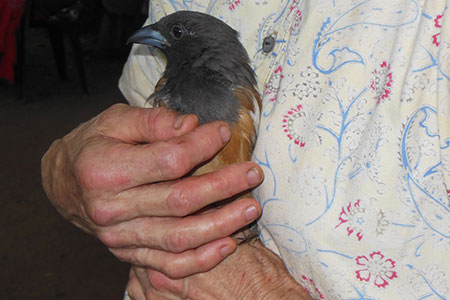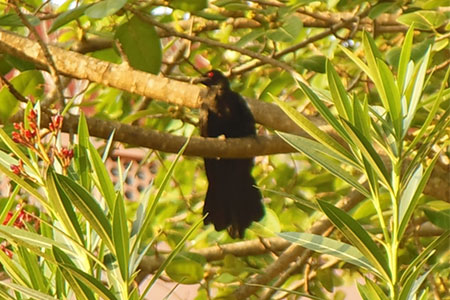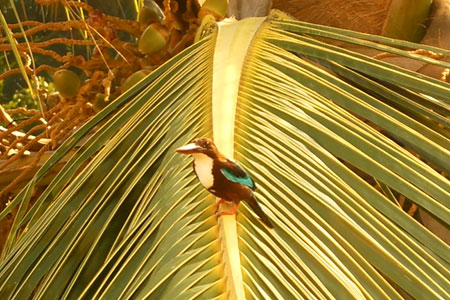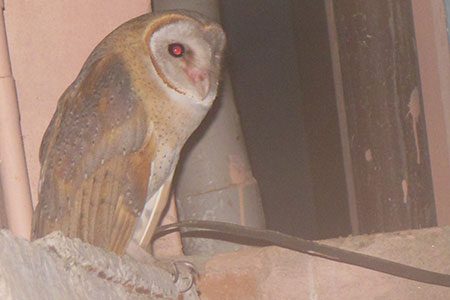Birds of all feathers assemble in Amritapuri
One wonders if seasonal changes matter to birds in Amritapuri at all.
In connection with the establishment of the Sringeri mutt by Sri Sankara there is specific mention of his seeing a snake offering shelter to a frog from sun and on that spot he built the ashram. An ashram is a place where no antagonistic feelings -otherwise natural to beings- arise, for an ashram is a shantidhama, an abode of peace.

Amritapuri seems a step ahead of this. In this shantidhama right now we see many new buildings coming up. Construction work never stops on this campus. Such a development presupposes disappearance of flora and fauna. Birds especially would go away in fear of sound and strangers- humans. But here we see a different development. Birds are coming closer and mingling with human lives. They are at your windows. They are on your terraces. They are in your gardens. They are in your potted plants, sucking nectar from flowers, or nibbling at the insects in them.

Not a year ago a visiting peacock was seen walking about in the ashram; he had actually landed on the roof of the International Office where he spent some two hours, just being there to be seen by many of us. Then he decided to leave, got down the roof, walked daintily past the erstwhile laundry, coconut peeling area, backyard of the erstwhile kitchen where they cut vegetables; past the round buildings of –, western canteen area; past the carpool, the hospital, past the construction workers digging the foundation for the now ready flats near the boy’s hostel. Then the road splits into three: the peacock chose to take to wings from that point! When I went along the trail looking for it, the women cutting veggies said, “Yes, the beautiful peacock walked this way.” When I went near the canteen, some westerners at the tables said, “Yes, the beautiful peacock walked this way.” When I went near the carpool, Manu saw me and guessed I was looking for the peacock and said, “Chechi, the beautiful peacock walked this way.” The workers on the foundation work said, “Haan ji, vo more idhar se aiyse chalte gaya.” It seemed a very casual thing. It looked like the peacock knew its path.

Now there is a new arrival: a green parakeet or parrot as we say in India. Last week one morning he showed his presence on Amma’s path to the stage for darshan. He must have been living with humans before. He sits on a low branch above our heads, beyond the reach of the longest arms. Show him some fruits, he just walks up a few steps indicating refusal; pull your hand down, he comes down to his previous heights. He calls very rarely and only purposefully.

In Amritapuri in all seasons, there is always the birds’ song in the air. At a time you can hear a tiny sunbird or nut-hatcher warbling by your window and a lone kingfisher screeching from its perch above your neighbour’s water-tank, and yet another bird, barbet invariably, chanting its ‘kutrr kutrr’ mantra from a yonder tree top. Or a pair or two of myna plying between tree branches and building sides, cackling and discussing, trying to decide something. Maybe about a lizard on the ground to be shared with a sauntering coucal; the coucal is gook-gooking for sometime over the same matter.

Soon one will realize how one had taken for granted the loud plaintive kuhoo kuhoo of the red eyed black koel; he is there almost all the time, calling plaintively and insistently, sometimes flying low above our heads, drawing attention: It is me, not your crow. Please, grant me some attention.

Only a decade ago we would sneer at the presence of so many loud crows and speak out about the absence of koels. Now things have changed so much as far as bird life in Amritapuri is concerned.
You should not be surprised if you see a magpie robin or a flame-back wood-pecker near food waste bins alongside crows who are not as noisy as before.

As if kites and shags were not enough to duck in water for fish in the backwater by the setu, seagulls and lapwings have started to come; also are seen green-winged big kingfisher and copper brown winged small kingfishers along the bank, thus increasing the number of fisher-bird community. This includes domestic ducks and sulking water-hens.

On an early-morning after-archana walk in the college campus, within 20 minutes you will see or hear at least one dozen kinds of birds every day. Tree-pies and drongos, bulbuls and colourful bee eaters perch with unity on the top twigs of the lone bamboo bush in the university. Any number of babblers will have spoken to each other about your regular walk looking for bird-friends. Though the egrets and herons are silent as ever, they maintain prominence what with their snow-white large wings, and dramatic landing pattern.

The three owls –owlets till last month- have stopped calling as they are now able to take to wings at dusk, and the juice stall and book stall area is now rid of their intermittent QQQQfffff’s.
– Sandhya

